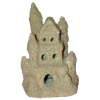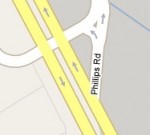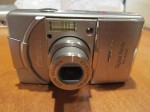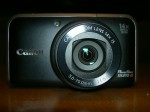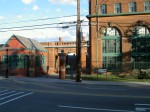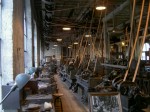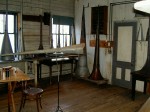I’ve been asked to compare and contrast our full time living in the 24′ Winnebago View 24H and the 35′ Winnebago Journey Express 34Y. The differences in the two led us two very different living styles.
In the View one of the first things we did was get a solar system so we could go and stay anywhere anytime. And that we did. We drove Historic Route 66 starting in downtown Chicago. We stayed at Corps of Engineer Dams where there were no official campgrounds. We stopped any place we wanted to for lunch, either taking two front to back parking spaces or backing into one at a curb where the back of our RV could hang over the edge. This nimble little rig could go nearly anywhere.
But, it also had to go nearly everywhere since we had no other means of transportation. It went to the grocery store. It went to the laundromat. It went to the hardware store. And wherever it went, both of us went as well since it took our house with it.
That was not a problem for the first year and a half of full time traveling. Because traveling was what we did. We moved every day or two. Small holding tanks were not a problem because we were always driving by a fresh water source or sanitary dump somewhere. And those water conserving techniques we used as tent campers worked well in the View. And the View got really good mileage so we didn’t mind taking the scenic routes. We just needed to be sure the fuel we were getting was ultra-low sulphur diesel. Fortunately, that appears to be readily available all around the U.S.
Then we moved into the Journey. It’s taller and wider as well as longer. Suddenly we don’t fit everywhere. Low hanging tree branches make city streets hazardous. Commercial parking lots require a whole bunch of spots into which we can park sideways while leaving room to get back out again. We can’t just drop into museums along our route knowing we’ll fit somewhere.
So we bought a car to tow behind the Journey. Now we are even longer. Plus, we can’t back up with the car attached. So when we came to a road that became a private road that Google Maps didn’t mention did that, we had to unhitch the car, turn around the motorhome, and rehitch the car before we could continue. (No, I didn’t take pictures, there were cars waiting for us to clear out of their way.)
And the 2-lane highways we loved traveling in the View become a challenge at each small town. Soon, we stopped enjoying those roads and started spending more time on the freeways we had avoided in the View.
Now we drive the motorhome mostly from one campground to the next campground with electrical hookups. (We haven’t installed solar on the Journey yet.) Since we pull a car we need a campsite that is 35′ long if we can park the car somewhere else or at least 55′ long if the car needs to fit, too. Only twice have we fit into a spot where we would not have been able to stay if we were driving a 40′ motorhome but part of that may be that we are now afraid to try to drive to some of the little parks we would have stayed at with the View. True, we could park the motorhome in some big box lot and take the car to look for the spots we used to camp in to see if our bigger RV would fit but we haven’t reached that stage in our new travel style yet.
Now we stay at most campgrounds for several days–often a week which is usually cheaper per night–while we use the car to explore the sights within an hour’s drive of that spot. In the car we can fit into any parking lot including that of any restaurant so we can, once again, go wherever we want.
Or we can not go. I can stay home while Dave runs errands. And staying home is a lot more comfortable than it was in the View. I have a recliner. We have a big screen TV for watching movies. We have a real bed in a room separate from our living room so I can stay up and read after Dave goes to bed. And we have huge tanks so I can stand under the shower without feeling like I am using up all our water.
But, when we go sightseeing we no longer have our own kitchen and bathroom with us. And in the motorhome we don’t get nearly as good mileage. And, on the road, we can’t stop just anywhere for lunch. I miss that.
There are a lot of things I like about both motorhomes. They, like life, are always a trade-off.
So, Lynne, you might want to keep your View until you find yourself feeling too limited by it’s size. That may never happen for you. You may just keep right on traveling.
TTYL,
Linda
